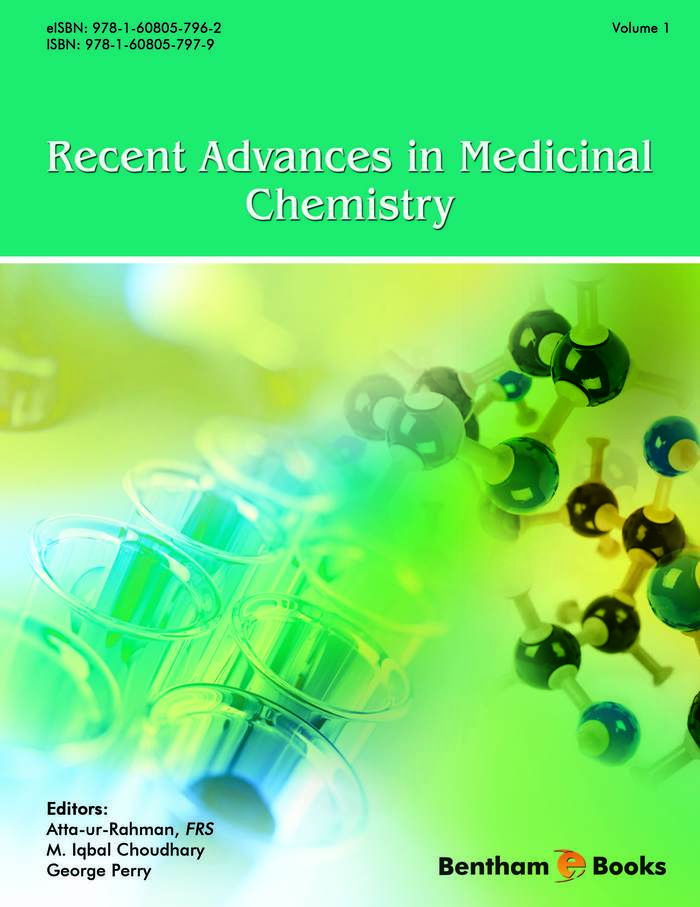The 1st volume of “Recent Adances in Medicinal Chemistry” offers a very rich
panorama of authoritative reviews covering old , as well as new, unexpected
issues. Once established, drugs rarely become undisputed therapeutic weapons
against one specific kind of disease and reevaluations of such drugs needs to be
carried out regularly. The present volume does indeed provide a number of such
reevaluations, as, for instance, the aureolic acid group of anti-cancer drugs and the
non-steroidal anti-inflammatory drugs (Chakraborty et al.). In the ever-expanding
collection of anti-cancer drugs, the aromatase inhibitor tamoxifen has long been
the gold standard to treat hormone-receptor positive, early forms of breast cancer.
However, new generation aromatase inhibitors show definitive advantages over
tamoxifen and these advantages are discussed by Colozza et al. On the same
subject, the precise identification of estrogen receptors is becoming of prime
importance in deciding which inhibitor to use (Nagai M. and Brentani M.M.).
The already widespread utilization of statins may further extend to neoplastic
diseases, as statins were shown to inhibit Rho-GTPases (often hyperexpressed in
tumors) by inhibiting the synthesis of their prenyl groups (C. Riganti).
New molecules such as plant glycosides (saponins) display anti-tumor activity
that could be utilized in combination with existing anti-tumor compounds (C.
Bachran et al.).
Chemoprevention undoubtedly offers effective means to delay or altogether
prevent the development of most diseases. Macáková et al., discuss extensively
the protective effects of tannins, a group of natural polyphenols with anti-oxidant
activity. On the same line, Young et al., consider the activity of carotenoids in the
chemoprevention of prostate cancer.
Delivery of pharmacologically active compounds and drugs was always of
importance to ascertain that active molecules preferentially reach their target cells
or tissues, and Murakami et al., review the recent advances in nanoparticular
vehicles.
Antimicrobials are acutely needed to treat bacterial diseases, especially those
caused by micro-organisms resistant to existing antibiotics. Pérez-Castillo et al., review how the 3-D structure of the targeted bacterial enzyme may be utilized to
design new antibiotics.
Enzymatic activities are essential to carry out biological functions and their
perturbations are often caused by disturbances of the intracellular redox potential.
In this respect, Nagahara reports on the mechanisms to maintain the cellular redox
equilibrium. The plasma membrane redox system is an important property of
plasma membranes. In particular, Avigliano et al., review the plasma membrane
redox system of blood platelets and the role of anti-oxidant vitamins in this
context.
The acute spinal cord injuries (traumatic) represent an unsolved problem in
medicine. H. Mestre et al., elaborate on the ongoing efforts made to develop a
pharmacological way to ensure the neuroprotection of the injured spine.
The precise assessement of the levels of pharmacologically active molecules in
patients needs to be met and Samanidou et al., review how HPLC (high-performance
liquid chromatography) can be utilized to monitor the levels of
tricyclic anti-depressants.
Lastly, Santucci et al., review chosen instances where misfolded proteins cause
pathologies, namely how non-native forms of cytochrome c are involved in
apoptosis triggering and participate in amyloid formation.
By the variety of subjects reviewed dealing with chemoprevention and treatment
of common diseases, the changing scope of action of medicinal chemistry is
illustrated in this volume. It is indeed quite possible that our physiology and
pathologies also evolve comcomittantly with the drugs we take to prevent or treat
diseases.
Daniel C. Hoessli
Panjwani Center for Molecular Medicine and Drug Research
International Center for Chemical and Biological Sciences
University of Karachi, Karachi-75270
Pakistan





